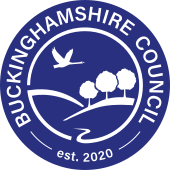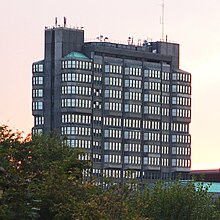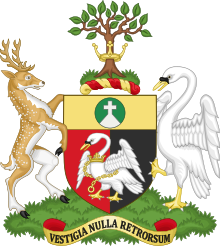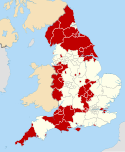Buckinghamshire Council | |
|---|---|
 Council logo | |
| Type | |
| Type | |
| History | |
| Founded | 1 April 2020 [a] |
| Preceded by | Buckinghamshire County Council |
| Leadership | |
Rachael Shimmin since July 2019 [1] | |
| Structure | |
| Seats | 147 |
Political groups |
|
| Elections | |
| First past the post | |
Last election | 6 May 2021 |
Next election | 1 May 2025 |
| Meeting place | |
 | |
| The Gateway, Gatehouse Road, Aylesbury, Buckinghamshire, HP19 8FF | |
| Website | |
|
www | |
Buckinghamshire Council is the local authority for the non-metropolitan county of Buckinghamshire in England. It is a unitary authority, performing both county and district-level functions. It was created on 1 April 2020, replacing the previous Buckinghamshire County Council and the councils of the four abolished districts of Aylesbury Vale, Chiltern, South Bucks, and Wycombe. The non-metropolitan county is smaller than the ceremonial county, which additionally includes Milton Keynes.
The county council had been established in 1889. The county was reformed in 1974, when it ceded Slough, Eton and nearby villages to Berkshire. In 1997 the borough of Milton Keynes was removed from the non-metropolitan county to become its own unitary authority.
The modern council has been under Conservative majority control since its creation, as had been the predecessor county council between the reforms of 1974 and its abolition in 2020.
History
County Council
Elected county councils were created in 1889 under the Local Government Act 1888, taking over administrative functions which had previously been performed by unelected magistrates at the quarter sessions. [2]

The first elections were held in January 1889 and the county council formally came into being on 1 April 1889, on which day it held its first meeting at County Hall in Aylesbury, the courthouse (completed 1740) which had served as the meeting place for the quarter sessions which preceded the county council. [3] The first chairman was Henry William Cripps, a QC from Marlow, who was also chairman of the quarter sessions. [4]
There were occasional changes to the county's boundaries, notably following the Local Government Act 1894, which said that parishes and districts could no longer straddle county boundaries. Linslade was transferred to Bedfordshire in 1965. [5]
Buckinghamshire was redesignated as a non-metropolitan county in 1974 under the Local Government Act 1972, which also transferred Slough, Eton, and nearby villages to Berkshire. Until 1974 the lower tier of local government comprised numerous municipal boroughs, urban districts and rural districts. They were also reorganised as part of the 1974 reforms into five non-metropolitan districts: Aylesbury Vale, Chiltern, Milton Keynes, South Bucks (called 'Beaconsfield' until 1980), and Wycombe. [6] [7]
In 1997 the borough of Milton Keynes was removed from the non-metropolitan county to become its own unitary authority. [8] Milton Keynes remains part of the ceremonial county of Buckinghamshire for the purposes of lieutenancy. [9]
Between 2016 and 2019 the government considered options for introducing unitary forms of local government across the whole county. The county council proposed abolishing the four remaining districts in its area and having one unitary authority. [10] The four districts proposed instead one unitary authority covering Aylesbury Vale and another covering the combined area of Chiltern, South Bucks and Wycombe. [11] The government ultimately decided to pursue the single unitary authority as proposed by the county council. The three southern districts considered seeking a judicial review of the government's decision, but ultimately decided against. [12] [13] The statutory instrument confirming the changes was issued in May 2019. [14]
On 12 March 2020, the last meeting of the county council took place, during which the council celebrated 131 years of service. [15]
Unitary authority
A shadow authority was established to oversee the transition to the new council, comprising all 202 councillors from the old county council and four district councils. The new unitary authority formally came into being on 1 April 2020. [14] [16]
The first elections to the new council had been due to be held in May 2020, but due to the COVID-19 pandemic the first election was postponed until the 2021 local elections. It was therefore announced on 18 March 2020 that all the current shadow authority members would automatically become councillors and the shadow executive members would form the cabinet. [17] They would stay in post until the inaugural election took place in May 2021. [18] [19]
Governance
As a unitary authority, Buckinghamshire Council provides both district-level and county-level functions. Legally, it is a district council which also performs the functions of a county council. [14] Most of its area is also covered by civil parishes, which form an additional tier of local government for their areas. The only exception is High Wycombe, which is an unparished area; the Buckinghamshire councillors for the town serve as charter trustees instead of it having a town council. [20] [21]
Political control
From the reforms of 1974 until its abolition in 2020, the Conservatives held a majority of the seats on the county council. [22] They have also held a majority of the seats on the new council since its formation in 2020: [23]
- Buckinghamshire County Council
| Party in control | Years | |
|---|---|---|
| Conservative | 1974–2020 | |
- Buckinghamshire Council
| Party in control | Years | |
|---|---|---|
| Conservative | 2020–present | |
Leadership
The leaders of the county council from 2001 until its abolition in 2020 were: [24]
| Councillor | Party | From | To | |
|---|---|---|---|---|
| David Shakespeare | Conservative | 28 Jun 2001 | 26 May 2011 | |
| Martin Tett | Conservative | 26 May 2011 | 31 Mar 2020 | |
Martin Tett has also served as leader of the new Buckinghamshire Council from its creation in 2020. [25]
| Councillor | Party | From | To | |
|---|---|---|---|---|
| Martin Tett | Conservative | 1 Apr 2020 | ||
Composition
As at March 2024, the composition of the council was: [26]
| Party | Councillors | |
|---|---|---|
| Conservative | 111 | |
| Liberal Democrats | 17 | |
| Independent | 7 | |
| Labour | 6 | |
| Wycombe Independent | 3 | |
| Independent Network | 2 | |
| Green | 1 | |
| Total | 147 | |
The Liberal Democrats and Wycombe Independents sit together as the "Alliance Grouping". Labour, the Green Party, Independent Network and six of the seven independent councillors form the "Impact Alliance". The other independent councillor does not belong to a group. The next election is due in 2025.
Elections
The council comprises 147 councillors representing 49 wards, with each ward electing three councillors. Elections are to be held every four years from 2025. [14] New ward boundaries have been drawn up to come into effect for the 2025 election, reducing the number of councillors to 97. [27]
Premises
The council has its headquarters and meeting place at The Gateway on Gatehouse Road in Aylesbury, being the former Aylesbury Vale District Council building, prior to which it was offices of Rexel. The building had been built in the 1990s as offices and was bought and substantially extended in 2008–2009 by Aylesbury Vale District Council, with the extensions including a council chamber. [28]

For most of its existence, the county council met at the old County Hall in the Market Square in Aylesbury. As the council's responsibilities grew, it needed additional office space. A new building called County Offices was built on Walton Street in 1929, immediately behind County Hall. [29]

A much larger office building was built on Walton Street opposite the County Offices in 1964–1966, known as New County Offices or New County Hall, being a 12-storey tower block designed by the county architect, Fred Pooley. [30] The building also became known as "Fred's Fort", or less flatteringly as "Pooley's Folly". [31]
Neither of the Walton Street buildings included a council chamber. Full council meetings continued to be held at the Old County Hall until 2012, when the council started meeting at the new council chamber that Aylesbury Vale District Council had built at The Gateway. When Buckinghamshire County Council and the constituent districts merged to become a unitary authority in 2020, consideration was given to where the new council should be based. One option considered was the creation of a council chamber within New County Hall. It was decided instead that the Aylesbury Vale District Council building at The Gateway should be the new council's headquarters, with New County Hall continuing to be used as additional office space. [32]
In late 2023, the council confirmed the planned sale of the former Chiltern District Council building in Amersham, potentially to be followed by the New County Hall tower block in Aylesbury. [33]
Logo


The logo of the new Buckinghamshire Council consists of a blue circle with a white swan flying above hills, with a row of three trees. The words 'Buckinghamshire Council' and 'est.2020' are written above and below respectively. The old logo of Buckinghamshire Council council consists of a swan in a black circle.
Notable members
- Frederick Verney (1846–1913), member from 1889 to 1907
- Tonman Mosley, 1st Baron Anslow (1850–1933), Chairman from 1904 to 1921
- Sir William Carlile, 1st Baronet (1862–1950)
- William Joseph Ashby (1885–1953)
- Sir Henry Aubrey-Fletcher, 6th Baronet (1887–1969)
- Sir Aubrey Ernest Ward (1899–1987), Chairman from 1963 to 1974
- Edward Curzon, 6th Earl Howe (1908–1984), Vice-Chairman 1974 to 1978
- John Darling Young (1910–1988)
- Sir Ralph Verney, 5th Baronet (1915–2001)
- Guthrie Moir (1917–1993), member from 1949 to 1975
- Brian White (1957–2016), later member of parliament for Milton Keynes
See also
References
- ^ It was formed in 1889 as "Buckinghamshire County Council" then reformed with different boundaries in 1974 as "Buckinghamshire County Council" then reformed with the same boundaries as "Buckinghamshire Council" in 2020.
- ^ Richardson, Hannah (7 April 2021). "Buckinghamshire chief executive is fifth highest paid in the country". The Bucks Herald. Retrieved 26 April 2023.
- ^ "Local Government Act 1888", legislation.gov.uk, The National Archives, 1888 c. 41, retrieved 29 March 2024
- ^ Historic England. "The County Hall, including the former Town Hall, the former County Constabulary Headquarters and the Judge's Lodgings (Grade II*) (1117935)". National Heritage List for England. Retrieved 29 March 2024.
- ^ "Bucks County Council". Buckingham Advertiser. 6 April 1889. p. 8. Retrieved 29 March 2024.
- ^ "Linslade Urban District". A Vision of Britain through Time. GB Historical GIS / University of Portsmouth. Retrieved 30 March 2024.
- ^ "The English Non-metropolitan Districts (Definition) Order 1972", legislation.gov.uk, The National Archives, SI 1972/2039, retrieved 29 March 2024
- ^ "The English Non-metropolitan Districts (Names) Order 1973", legislation.gov.uk, The National Archives, SI 1973/551, retrieved 29 March 2024
- ^ "The Buckinghamshire (Borough of Milton Keynes) (Structural Change) Order 1995", legislation.gov.uk, The National Archives, SI 1995/1769, retrieved 30 March 2024
- ^ "Lieutenancies Act 1997", legislation.gov.uk, The National Archives, 1997 c. 23, retrieved 30 March 2024
- ^ "Unitary plan for Buckinghamshire backed". 12 March 2018. Retrieved 26 January 2019.
- ^ Eichler, William (18 January 2017). "Buckinghamshire councils submit proposals for two unitary authorities". Local Gov. Retrieved 30 March 2024.
- ^ Rapson, Jasmine (25 January 2019). "District council joins plans to take legal action over 'undemocratic' unitary authority". Bucks Free Press. Retrieved 26 January 2019.
- ^ "Latest on the new unitary council for Buckinghamshire - Judicial Review decision". South Bucks District Council. Retrieved 30 March 2024.
- ^ a b c d "The Buckinghamshire (Structural Changes) Order 2019", legislation.gov.uk, The National Archives, SI 2019/957, retrieved 30 March 2024
- ^ "Bucks County Council takes final curtain call after 131 years". Bucks Herald. 16 March 2020. Retrieved 21 August 2020.
- ^ "Buckinghamshire Council replaces 5 other councils TODAY - everything you need to know". Bucks Free Press. 1 April 2020. Retrieved 7 April 2020.
- ^ "Coronavirus cancels local elections until 2021 – This is what is going to happen with the new unitary council". Bucks Free Press. 20 March 2020. Retrieved 31 March 2020.
- ^ "New council outlines political arrangements following postponement of elections". Buckinghamshire Council Shadow Authority. 18 March 2020. Archived from the original on 7 April 2020. Retrieved 31 March 2020.
- ^ Statutory Instrument 2020 No. 426 The Local Government (Coronavirus) (Structural Changes) (Consequential Amendments) (England) Regulations 2020
- ^ "Election Maps". Ordnance Survey. Retrieved 30 March 2024.
- ^ Smith, Charlie (13 February 2024). "Does High Wycombe need a town council? Share your view". Bucks Free Press. Retrieved 30 March 2024.
- ^ "Compositions calculator". The Elections Centre. Retrieved 30 March 2024.
- ^ "Your Councillors by Party". Buckinghamshire Council - Democracy. Retrieved 7 April 2020.
- ^ "Council minutes". Buckinghamshire Council. Retrieved 6 June 2022.
- ^ "Council minutes". Buckinghamshire Council. Retrieved 6 June 2022.
- ^ "Your councillors by party". Buckinghamshire Council. Retrieved 18 May 2023.
- ^ "The Buckinghamshire (Electoral Changes) Order 2023", legislation.gov.uk, The National Archives, SI 2023/1205, retrieved 30 March 2024
- ^ "Aylesbury Vale District Council offices to be central point for the new Buckinghamshire Council". Bucks Herald. 13 September 2019. Retrieved 7 April 2020.
- ^ "Former County offices in Aylesbury set to be converted into 46 flats". Buckinghamshire Live. 25 April 2021. Retrieved 28 March 2022.
- ^ Aylesbury Town Council history
- ^ The Guardian dated 24 March 1998, p. 14
- ^ "Buckinghamshire Shadow Executive meeting , 20 August 2019". Buckinghamshire Council. Retrieved 18 May 2022.
- ^ Smith, Charlie (20 December 2023). "Council to sell offices to fund school and vehicles". BBC News. Retrieved 14 April 2024.
